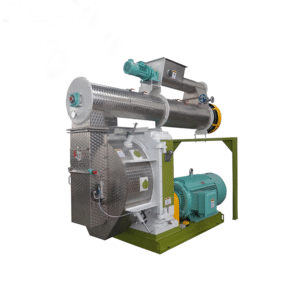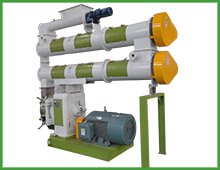Description
Technical Specifications & Engineering Excellence
Extrusion System Configuration
-
Motor Power: 55-160 kW (based on capacity requirements)
-
Die Diameter: 380-800 mm (marine-grade stainless steel)
-
L/D Ratio: 10:1 to 16:1 (optimized for shrimp feed)
-
Screw Speed: 150-400 RPM (variable frequency control)
Conditioning & Pre-processing
-
Pre-conditioner: Double-shaft paddle design with 90-180 second retention
-
Steam Injection: Precision proportional control system
-
Liquid Addition: Multiple injection points for oils and binders
-
Moisture Control: 26-32% preconditioning moisture content
Pellet Formation & Sizing
-
Die Hole Diameter: 1.0-2.5 mm (species-specific configurations)
-
Pellet Length Control: 1.5-3.0 mm (adjustable rotary cutter)
-
Production Capacity: 1-8 tons/hour (depending on formulation)
-
Pellet Density: 450-550 g/L (sinking characteristics)
Performance Specifications by Shrimp Species
| Shrimp Species | Pellet Size | Water Stability | Production Rate | Special Requirements |
|---|---|---|---|---|
| Whiteleg Shrimp | 1.2-2.0 mm | >4 hours | 3-6 tons/hour | High protein (>35%) |
| Black Tiger Shrimp | 1.5-2.5 mm | >5 hours | 2-5 tons/hour | Enhanced immunostimulants |
| Freshwater Prawn | 2.0-2.5 mm | >3 hours | 2-4 tons/hour | Vegetable protein focus |
| Broodstock Feeds | 1.8-2.2 mm | >6 hours | 1-2 tons/hour | Specialized nutrient packages |
Quality Control Parameters:
-
Starch Gelatinization: 85-92% for optimal binding and digestibility
-
Pellet Durability: >95% (PDI index)
-
Water Stability: 3-6 hours without significant disintegration
-
Fines Generation: <3% of total production
Innovative Features & Technological Advancements
Precision Die Technology
-
Multi-layer die design with specialized compression ratios
-
Tungsten carbide inserts for extended wear life
-
Quick-change die cartridge systems
-
Custom hole patterns for specific buoyancy characteristics
Intelligent Process Control
-
PLC-based automation with recipe management
-
Real-time temperature and pressure monitoring
-
Automatic moisture adjustment systems
-
Production data logging and traceability
Sanitary Design Features
-
USDA-approved materials and finishes
-
CIP (Clean-in-Place) capability
-
Quick-disassembly components
-
Allergen control protocols
Operational Performance & Economic Benefits
Production Efficiency Metrics
-
Energy Consumption: 45-65 kWh/ton (optimized systems)
-
Production Yield: >97% (material utilization)
-
Uptime Performance: >92% (preventive maintenance programs)
-
Changeover Time: <30 minutes between formulations
Economic Advantages
-
Feed Conversion Ratio: 1.2-1.6 (improved farming efficiency)
-
Production Costs: $25-45/ton (energy, maintenance, labor)
-
Quality Premium: 15-30% higher product value vs conventional feeds
-
Return on Investment: 18-30 months (typical payback period)
Case Study: A Vietnamese shrimp feed manufacturer documented these improvements after upgrading to a modern pellet mill:
-
Production capacity increased by 35%
-
Pellet durability improved from 88% to 96%
-
Water stability extended from 2 to 4.5 hours
-
FCR improved from 1.8 to 1.4 in farm trials
Industry Applications & Customization Options
Hatchery Feeds
-
Micro-pellets (0.8-1.2 mm) for post-larvae
-
High protein content (45-55%)
-
Enhanced digestibility features
-
Probiotic and prebiotic incorporation
Grow-out Feeds
-
Standard production pellets (1.5-2.2 mm)
-
Balanced energy-protein ratios
-
Disease resistance enhancers
-
Environmentally friendly formulations
Specialty Feeds
-
Functional feeds with health benefits
-
Organic and sustainable formulations
-
Breed-specific nutritional profiles
-
Value-added ingredient incorporation
Maintenance & Operational Excellence
Preventive Maintenance Schedule
-
Daily: Die and roller inspection, lubrication check
-
Weekly: Wear component measurement, belt tension verification
-
Monthly: Gearbox oil analysis, bearing condition assessment
-
Quarterly: Complete system audit and calibration
Operational Best Practices
-
Regular die and roller gap adjustment (0.1-0.3 mm)
-
Proper steam quality maintenance (dry saturated steam)
-
Consistent raw material quality control
-
Operator training and certification programs
Future Development Trends
Emerging Technologies
-
AI-driven process optimization
-
Real-time nutrient preservation monitoring
-
Integrated quality control systems
-
Sustainable energy integration
Market Directions
-
Increased demand for functional feeds
-
Sustainability and traceability requirements
-
Customized nutritional solutions
-
Digital integration with farming operations





Reviews
There are no reviews yet.